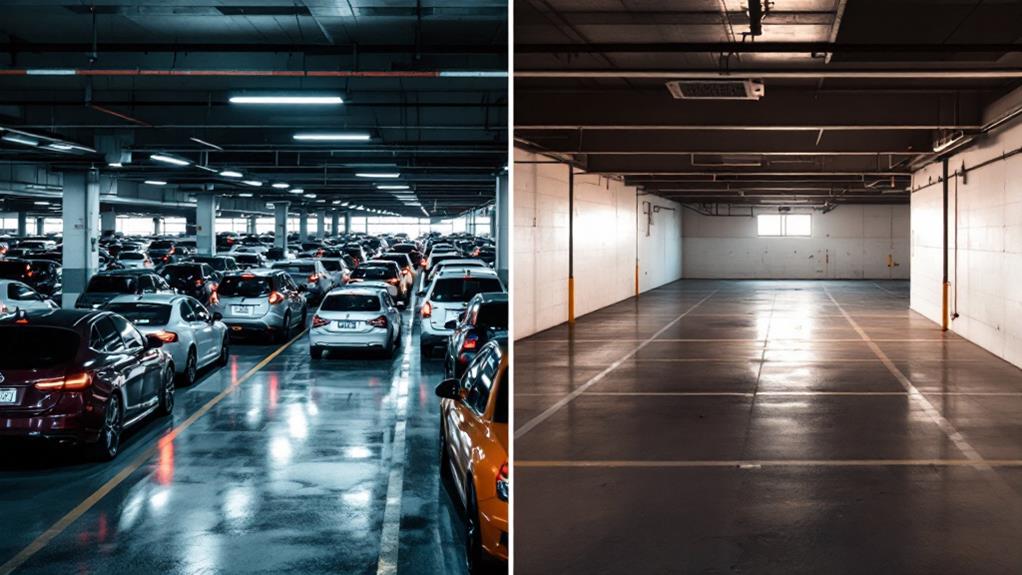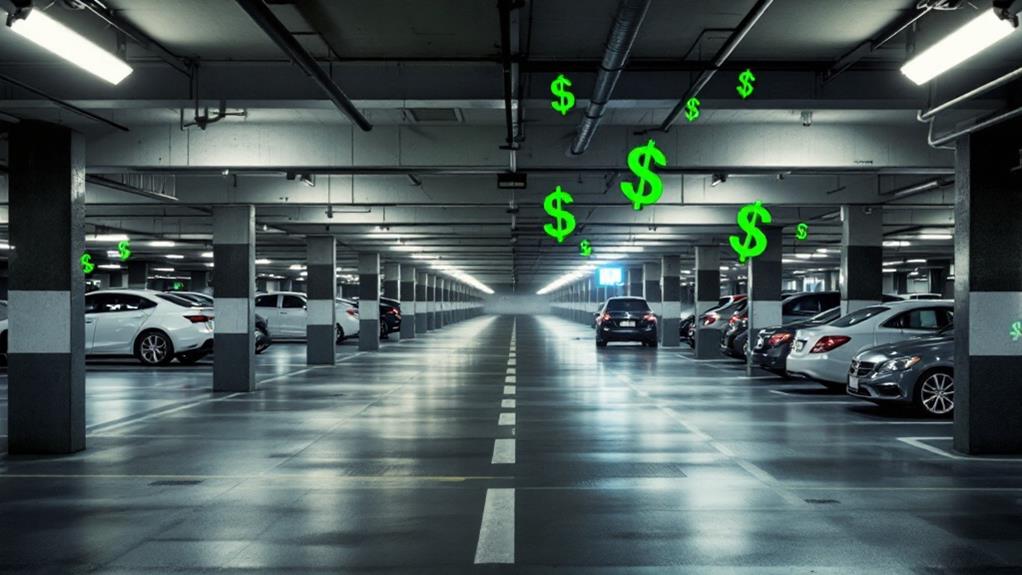Comparing Monthly vs. Hourly Rates in Public Garages

Public garages typically offer both monthly and hourly parking rates to cater to different user needs. Monthly rates provide cost savings for frequent parkers and a guaranteed spot, while hourly rates offer flexibility for short-term users. You'll find monthly passes more economical if you park regularly, but hourly rates might suit you better for occasional use. Cities use this dual pricing model to balance steady income from long-term parkers with the potential for higher revenues from short-term users. The choice between monthly and hourly rates depends on your parking habits and budget. Understanding the pros and cons of each option can help you make the most cost-effective decision for your situation.
Understanding Public Garage Pricing Models
Many public garages employ a dual pricing model to cater to different parking needs and maximize revenue. You'll often find two primary options: monthly reserved passes and hourly or daily transient rates. This approach allows parking garages to balance their parking supply between long-term and short-term users.
Monthly parking rates can vary dramatically, ranging from as low as $25 to a staggering $770 per month. You'll typically encounter the highest parking prices in Northeast and West Coast cities. For those seeking short-term options, hourly and daily rates in parking lots can span from $5 to over $50 per day, with similar geographical price trends.
When setting parking prices, garage operators must carefully consider various factors. These include current occupancy levels, operational costs, and the demand for different parking durations. By optimizing the balance between monthly and hourly rates, parking garages can maximize their revenue while maintaining attractive options for both regular commuters and occasional visitors. This delicate balance is essential for the financial success of public parking facilities and helps guarantee efficient use of available parking spaces in urban areas.
Benefits of Monthly Parking Rates
Commuters and regular parkers often find that monthly parking rates offer a host of advantages. When you opt for a monthly parking pass, you'll typically enjoy lower costs per hour compared to standard hourly rates. This can lead to significant savings, especially if you're a frequent parker or daily commuter.
For parking garage operators, monthly passes provide a stable revenue stream by guaranteeing consistent occupancy and income. This predictability allows them to better manage their parking capacity and resources. As a monthly parker, you'll benefit from a guaranteed spot, reducing the stress of searching for parking in high-demand areas.
Monthly parking rates also encourage longer-term usage, which can lead to more efficient use of parking capacity. You'll find that many employers subsidize monthly parking passes, further reducing your out-of-pocket expenses. This arrangement creates a win-win situation for both parkers and garage operators.
Advantages of Hourly Parking Rates

The parking meter's ticking clock represents the flexibility and efficiency of hourly parking rates. When you opt for hourly rates in public parking garages, you're tapping into a system that offers numerous advantages for both cities and parkers alike.
Hourly rates enable cities to implement fluctuating pricing, adjusting fees based on parking demand. This approach can considerably increase revenue compared to fixed monthly rates. You'll also find that hourly rates encourage higher turnover of parking spaces, ensuring more efficient use of limited parking resources in busy urban areas.
If you're environmentally conscious, you'll appreciate how hourly rates can discourage long-term parking and incentivize alternative transportation modes. This shift helps reduce congestion and emissions in city centers. As a parker, you'll enjoy the flexibility of paying only for the time you need, rather than committing to a fixed monthly fee.
Cities benefit from hourly rates as a tool to manage parking demand and influence travel behavior. By implementing this system, urban planners can work towards broader transportation goals, creating more sustainable and efficient city environments. Ultimately, hourly rates in public parking offer a win-win solution for both cities and parkers.
Revenue Implications for Cities
While hourly rates offer numerous advantages, cities must carefully consider the revenue implications when setting parking prices. As a public sector entity, you're tasked with recovering costs for debt service and operations of parking garages. Monthly prices for reserved parking stalls provide a steady income stream, but they limit your ability to maximize usage through variable pricing.
On the other hand, transient parking revenue is more volatile but can be heightened through demand-responsive pricing. To strike the right balance, you'll need to analyze occupancy rates and usage patterns carefully. This data will help you determine the ideal mix of monthly and hourly parking prices to guarantee efficient utilization and optimize total revenue.
As parking operators, you should consider that monthly parker rates may provide stability, but they can also lead to underutilized spaces during off-peak hours. By implementing a strategic blend of monthly and hourly rates, you can capture both the reliability of long-term parkers and the potential for higher revenues from short-term users. This approach allows you to adapt to changing demand patterns and maximize your parking garage's financial performance.
Impact on Parking Space Utilization

Three key factors influence parking space utilization when comparing monthly and hourly rates. First, monthly rates can drive consistent occupancy, ensuring reserved spaces are regularly used. This stability can be beneficial for long-term planning but may lead to underutilization during off-peak hours. Second, hourly rates typically promote higher turnover, especially during busy periods, maximizing the use of available spaces throughout the day.
To optimize utilization, you'll want to strike a balance between monthly and hourly products. This approach allows you to cater to both long-term parkers and short-term visitors, potentially increasing overall occupancy. Utilization data is essential in making informed pricing decisions. By analyzing occupancy patterns, you can adjust rates to achieve target levels for both monthly and hourly parkers.
Consider implementing adaptable pricing strategies based on time of day and demand. This approach can further enhance space utilization by encouraging parkers to adjust their behavior. For example, lower rates during off-peak hours can incentivize use during typically underutilized periods. By leveraging these strategies, you'll be better equipped to maximize the efficiency of your public garage spaces.
Balancing Predictability and Flexibility
Balancing predictability and flexibility is a key challenge when setting garage rates. As a city planner or parking manager, you'll need to weigh the benefits of monthly passes against hourly pricing options. Monthly passes provide a steady revenue stream, but they can limit your ability to manage occupancy effectively. On the other hand, hourly rates offer greater flexibility in pricing based on demand, encouraging turnover and maximizing space utilization.
To strike the right balance, consider implementing a combination of monthly and hourly options. This approach allows you to maintain a predictable income while retaining the flexibility to adjust pricing for transient parkers. Conduct data-driven analysis of occupancy patterns and price sensitivity to determine the essential mix of monthly and hourly rates for your public parking facilities.
Remember that effective communication is indispensable when managing these tradeoffs. Keep monthly pass holders informed about any changes to their privileges, and clearly communicate hourly rate adjustments to transient parkers. By carefully balancing predictability and flexibility in your parking pricing strategy, you'll be better equipped to meet the needs of both regular and occasional garage users while optimizing revenue and occupancy levels.
Demand-Based Pricing Strategies

Numerous cities are turning to demand-based pricing strategies to optimize their parking garage utilization. You'll find that these strategies set parking rates based on occupancy levels, aiming to maintain 85-95% occupancy during peak periods. This approach guarantees availability while maximizing revenue for cities.
You might be interested to know that demand-based pricing has shown promising results. For instance, the SFpark program in San Francisco adjusted prices for 11,500 off-street parking spaces in 14 city-owned garages. Their goal? To charge the lowest possible rates while keeping 20-40% of spaces open.
These strategies aren't just about revenue, though. They've been proven to increase public use of garages by more than a third while maintaining a stable revenue stream for cities. It's a win-win situation.
Looking ahead, there's potential to extend these principles to non-city off-street spaces. This is an exciting area for future research, especially since detailed occupancy data is more readily available in off-street parking settings.
As you consider parking options, remember that demand-based pricing aims to balance availability with affordability, making it easier for you to find a spot when you need one.
Technology's Role in Rate Management
Parking garages are becoming smarter thanks to technological advancements in rate management. You'll find that automated parking systems now allow real-time monitoring of occupancy and fluid adjustments to parking rates. This means garages can optimize their pricing strategies based on current demand, maximizing both utilization and revenue.
When you use a modern parking garage, you're likely interacting with integrated payment platforms that enable seamless transactions. These systems collect important parking data, which is then analyzed to identify peak demand periods and adjust rates accordingly. You'll benefit from this technology through more efficient parking experiences and potentially lower costs during off-peak hours.
Mobile apps have also revolutionized how you interact with parking facilities. You can now access information on availability and pricing before you even arrive, helping you make informed decisions about where to park. This technology supports demand-responsive pricing models, allowing garage operators to fine-tune their rates based on real-time occupancy data.
As a result, you'll find that parking rates are becoming more fluid and responsive to actual usage patterns, whether you're considering monthly or hourly options.
Case Studies: Successful Pricing Approaches

How have cities successfully implemented innovative pricing strategies for their parking garages? San Francisco's SFpark program stands out as a prime example. By adjusting prices for 11,500 off-street parking spaces in 14 city-owned facilities, SFpark increased public use by more than one-third. This demand-responsive pricing approach not only generated considerable revenue but also maintained a stable income stream while slightly lowering average prices for drivers.
You'll find that demand-sensitive parking management principles can be easily applied to non-city off-street locations as well. In fact, more detailed occupancy data is often available in off-street environments compared to on-street parking. Cities can optimize their public garage assets by adopting one of three pricing approaches: marginal cost pricing, market rate pricing, or pricing to reach a specific revenue goal.
It's worth noting that public-private partnerships in off-street parking management deserve more attention. Current analyses of public off-street management are limited compared to the extensive literature on public on-street parking. By exploring these collaborations, cities may uncover new opportunities to enhance their parking strategies and improve overall efficiency.



